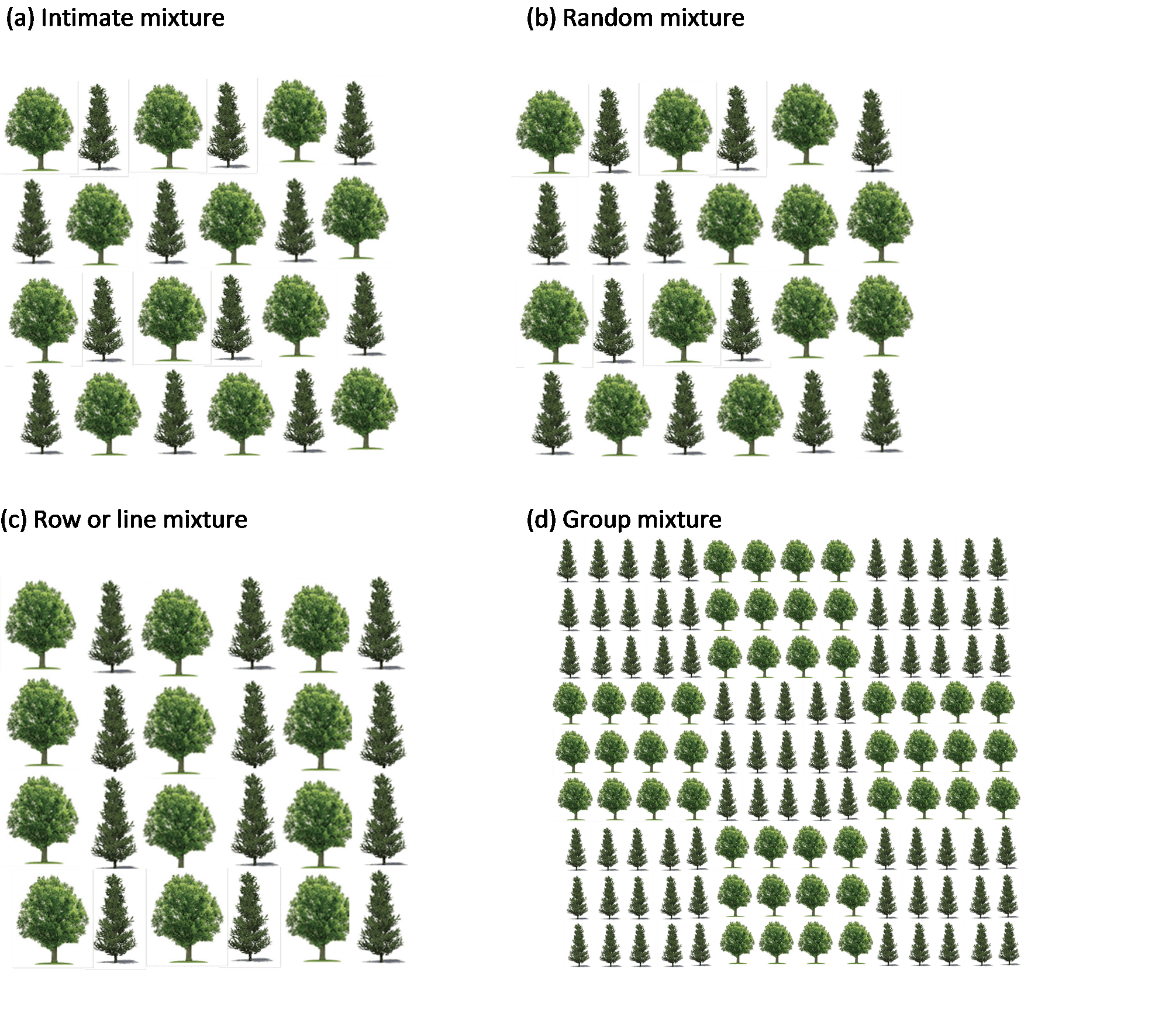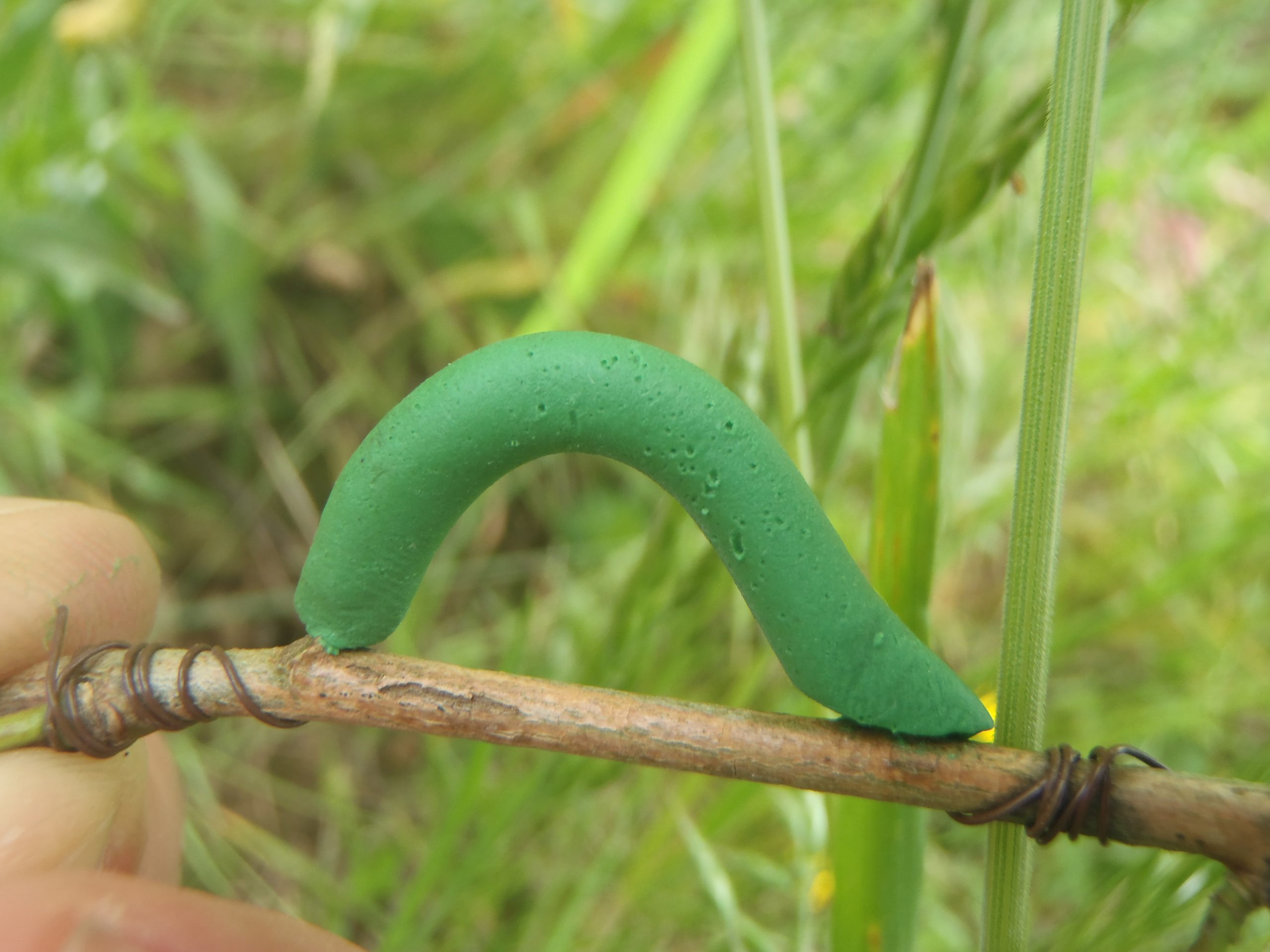Summary
Woodland Diversification
Managing woodland stands in a way that retains productivity targets, but that also fosters biodiversity and stand resilience are key sustainable forest management goals. Current forestry policy advocates a diversification of woodland stands to achieve these goals, favouring mixed age structures, trees of mixed provenance and polycultures over single-aged monocultures. Evidence is lacking, however, to support this management recommendation as a measure that is assumed to 1) enhance resilience to pests and pathogens and 2) contribute to biodiversity gains and related ecosystem service delivery.

Research Objectives
- To compare woodland biodiversity and related ecosystem functioning in single-aged monocultures compared with ‘diversified’ (i.e. mixed species, or mixed aged) woodland stands.
- To investigate in experimental planting trials the survival, growth, phenology and associated biodiversity of single provenance, single species stands compared with mixed provenance, mixed species stands.
- To assess in experimental planting trials levels of insect herbivore and fungal pathogen damage and rates of insect predation in single provenance, single species stands compared with mixed provenance, mixed species stands.
- To gain a better understanding of the current practical experience of conversion of conifer plantation monocultures to more structurally complex native woodland in Britain and reported influences on forest biodiversity
General Content
Approaches taken
- Multi-taxa species and functional diversity have been assessed in 42 mixed and monoculture stands of oak (Quercus robur) and Scots pine (Pinus sylvestris) in three different forested regions (Thetford Forest – Norfolk, the New Forest – Hampshire and numerous woodland across the Republic of Ireland). Taxonomic groups sampled include ectomycorrhizal fungi, bryophytes, vascular plants and arthropods of the forest floor and ground vegetation layers.

Artificial caterpillar used in insect predation studies
- Assessments of oak (Quercus robur), cherry (Prunus avium), sweet chestnut (Castanea sativum) and ash (Fraxinus excelsior) survival, growth, phenology and associated biodiversity have been conducted at experimental ‘Climate-match’ planting trials in Kent and the Midlands where these species are planted in single provenance and single species blocks but also in mixed provenance, mixed species blocks. Levels of foliar insect herbivore and fungal pathogen damage and insect predation have also been studied. Insect herbivores assessed include three different insect guilds: cynipid gall wasps (“gallers”), leaf miners, and leaf manipulators. The fungal pathogen studied is oak powdery mildew.
- Multi-taxa species and functional diversity have been assessed in monocultures and two-species mixtures of sessile oak (Quercus petraea), Scots pine (Pinus sylvestris), common alder (Alnus glutinosa), Norway spruce (Picea abies) and Sitka spruce (Picea sitchensis) at the Gisburn Experimental trials in Lancashire.
- A literature review has been completed reviewing the impacts on biodiversity of conversion of non-native conifer plantation monocultures to more structurally complex, native woodland. A survey has also been completed based on questionnaires circulated to woodland owners in Britain to better understand prevailing attitudes to the conversion of non-native to native woodland, the extent of conversion taking place and how this is achieved. This work is now summarised in an FC Research Note.
Publications
Peer Reviewed papers
Jensen, J. Blondeel, H., Guillemot, J., Schnabel, F., Serrano-León, H., Auge, H., Lander Baeten, L. Barsoum, N., et al. (2025) Diversity in resource use strategies promotes productivity in young planted tree species mixtures. Global Change Biology (in press)
Felix, J., Barsoum, N., Stevenson, P., Koricheva, J. (2025) Stand diversity does not mitigate increased herbivory on climate-matched oaks in an assisted migration experiment. Plant, Cell and Environment 48 (5): 3620-3631.
Field, E., Hector, A., Barsoum, N. and Koricheva, J. (2025) Tree diversity reduces pathogen damage in temperate forests: a systematic review and meta-analysis. Forest Ecology and Management 578, 12239.
Luo, S., Schmid, B., Hector, A., Scherer-Lorenzen, M., Verheyen, K., Barsoum, N., Bauhus, J., Beyer, F., Bruelheide, H., Ferlian, O., Godbold, D., Hall, J., Hajek, P., Huang, Y., Hoelscher, D., Kreft, H., Liu, X., Messier, C., Nock, C., Paquette, A., Parker, J.D., Parker, W.C., Paterno, G.B., Reich, P., Rewald, B., Sandén, H., Sinacore, K., Stefanski, A., Williams, L., Eisenhauer, N. (2024) Mycorrhizal associations modify tree diversity−productivity relationships in experimental tree plantations. New Phytologist, 243 (3): 1205-1219
Vázquez-González, C., Castagneyrol, B., Muiruri, E., Barbaro, L., Abdala-Roberts, L., Barsoum, N., Fründ, J., Glynn, C., Jactel, H., Mereu, S., Kailen, A., Mooney, A., Morillas, L., Nock, C.N., Paquette, A., Parker, W.C., Roales, J., Scherer-Lorenzen, M., Schuldt, A., Verheyen, K., Weih, M., Yang, B., Koricheva, J. (2024) Tree diversity enhances predation by birds but not by arthropods across climate gradients. Ecology Letters 27(5), p.e14427.
Blondeel, H., Guillemot, J., Martin-St Paul, N., Druel, A., Bilodeau-Gauthier, S., Bauhus, J., Grossiord, C., Hector, A., Jactel, H., Jensen, J., Messier, C., Muys, B., Serrano-León, H., Auge, H., Barsoum, N. et al. (2024) Tree diversity reduces variability in sapling survival under drought. Journal of Ecology, 112(5), pp.1164-1180.
Zheng, L., Barry, K.E., Guerrero-Ramírez, N.R., Craven, D., Reich, P.B., Verheyen, K., Scherer-Lorenzen, M., Eisenhauer, N., Barsoum, N. et al. (2024) Effects of plant diversity on productivity strengthen over time due to trait-dependent shifts in species overyielding. Nature Communications, 15(1), p.2078.
Depauw, L., De Lombaerde, E., Dhiedt, E., Blondeel, H., Auge, H., Barsoum, N. et al. (2024) Enhancing tree performance through species mixing: Review of a quarter-century of TreeDivNet experiments reveals research gaps and practical insights. Current Forestry Reports 10, 1–20. https://doi.org/10.1007/s40725-023-00208-y
Desie, E., Zuo, J., Verheyen, K., Djukic, I., Van Meerbeek, K., Auge, H., Barsoum, N., … (2022) Disentangling drivers of litter decomposition in a multi-continent network of tree diversity experiments. Science of the Total Environment, 857 (3) https://doi.org/10.1016/j.scitotenv.2022.159717
Messier, C., Bauhus, J., Sousa-Silva, R., Auge, H., Baeten, L., Barsoum, N., … & Zemp, D.C. (2021) For the sake of resilience and multifunctionality, let’s diversify planted forests! Conservation Letters https://doi.org/10.1111/conl.12829 ***Wiley Top cited article 2021-2022***
Kwon T, Shibata H, Kepfer-Rojas S, Schmidt IK, Larsen KS, Beier C, Berg B, Verheyen K, Lamarque J-F, Hagedorn F, Eisenhauer N, Djukic I and TeaComposition Network (2021) Effects of climate and atmospheric nitrogen deposition on early to mid-term stage litter decomposition across biomes. Frontiers in Forests and Global Change, 4:678480 https://doi.org/10.3389/ffgc.2021.678480
Poeydebat, C., Jactel, H., Moreira, X., Koricheva, J., Barsoum, N., et al. (2021). Climate affects neighbour-induced changes in leaf chemical defences and tree diversity-herbivory relationships. Functional Ecology 35 (1), 67-81 https://doi.org/10.1111/1365-2435.13700
Field, E., Castagneyrol, B., Gibbs, M., Jactel, H., Barsoum, N., Schönrogge, K. and Hector, A. (2020) Associational resistance to both insect and pathogen damage in mixed forests is modulated by tree neighbour identity and drought. Journal of Ecology DOI: 10.1111/1365-2745.13397
Field, E., Schönrogge, K., Barsoum, N., Hector, A. and Gibbs, M. (2019) Individual tree traits shape insect and disease damage on oak in a climate‐matching tree diversity experiment. Ecology and Evolution, 9(15): 8524-8540.
Grossman, J.J., Vanhellemont, M., Barsoum, N., Bauhus, J., Bruelheide, H., Castagneyrol, B., Cavender-Bares, J., Eisenhauer, N., Ferlian, O., Gravel, D., Hector, A., Jactel, H. et al. (2018) Synthesis and future research directions linking tree diversity to growth, survival, and damage in a global network of tree diversity experiments. Environmental and Experimental Botany, 152: 68-89 doi: 10.1016/j.envexpbot.2017.12.015
Paquette, A., Hector, A., Castagneyrol, B., Vanhellemont, M., Koricheva, J., Scherer-Lorenzen, M., Verheyen, K., Abdala-Roberts, L., Auge, H., Barsoum, N. et al. (2018) A million and more trees for science. Nature Ecology & Evolution, 2: 763–766.
Bellamy, C., Barsoum, N., Cottrell, J. and Watts, K. (2018) Encouraging biodiversity at all scales in support of resilient woodlands. Forestry Commission Research Note FCRN033. Forestry Commission, Edinburgh.
Suz, L.M., Kallow, S., Reed, K., Bidartondo, M.I. and Barsoum, N. (2017) Pine mycorrhizal communities in pure and mixed pine-oak forests: abiotic environment trumps neighboring oak host effects. Forest Ecology and Management, 406:370-380. DOI:https://dx.doi.org/10.1016/j.foreco.2017.09.030
Barsoum, N., Coote, L., Eycott, A.E., Fuller, L. and Kiewitt, A. and Davies, R.G. (2016) Diversity, functional structure and functional redundancy of woodland plant communities: how do mixed tree species plantations compare with monocultures? Forest Ecology and Management, 382, 244-256.
Barsoum, N. and Henderson, L. (2016) Converting planted non-native conifer to native woodlands: a review of the benefits, drawbacks and experience in Britain. Forestry Commission Research Note 24. Forestry Commission, Edinburgh.
Verheyen, K., Vanhellemont, M., Auge, H., Baeten, L., Baraloto, C., Barsoum, N., Bilodeau-Gauthier, S. Bruelheide, H., Castagneyrol, B., Godbold, D., Haase, J., Hector, A., Jactel, H., Koricheva, J., Loreau, M., Mereu, S., Messier, C., Muys, B., Nolet, P., Paquette, A., Parker, J., Perring, M., Ponette, Q., Potvin, C., Reich, P., Smith, A. & Scherer-Lorenzen, M. (2016) Contributions of a global network of tree diversity experiments to sustainable forest plantations. Ambio 45(1): 29-41.
Barsoum, N., Fuller, L, Ashwood, F., Reed, K., Bonnet-Lebrun, A.-S. and Leung, F (2014) Ground-dwelling spider (Araneae) and carabid beetle (Coleoptera: Carabidae) community assemblages in mixed and monoculture stands of oak (Quercus robur L./Quercus petraea (Matt.) Liebl.) and Scots pine (Pinus sylvestris L.). Forest Ecology and Management. 321: 29–41.
Conference Proceedings
Barsoum, N., Bonnet-Lebrun, A-S., Brunt, J., Eycott, A., Kallow, S., Kiewitt, A. and Bidartondo, M. (2012) ‘Multitaxon responses to a ‘diversification’ in the composition of forest stands as an adaptation measure to global environmental change’ Conference Proceedings ‘Tackling climate change: contribution of forest scientific knowledge’ Tours, France.
Barsoum, N., McCartan, S., Wilkinson, M., Morison, J., Cottrell, J., Hubert, J. and Ray, D. (2011). Increasing the adaptation potential of native tree species to climate change. Conference Proceedings Joint BES – Natural England Meeting ‘Adapting Conservation to a Changing Climate’ 11-12 January 2011, Charles Darwin House, London.
Barsoum, N., Williams, D., Straw, N., Jukes, M., Johnson, R., Bidartondo, M., Kiewitt, A. and Ibrahim, R. (2009). Consequences of increased stand structural complexity for floral diversity and the prevalence of insect pests in Sitka spruce (Picea sitchensis) stands. Conference Proceedings ‘Adapting Forest Management to Maintain the Environmental Services: Carbon Sequestration, Biodiversity, Water’. Koli National Park, Finland 21.9.-24.9.2009.
Funding & Partners
- Management of multifunctional forests (MULTIFOR) ADAFOR FC Programme entitled : Habitat management, protected species, biodiversity, genetic conservation and forest reproductive materials TreeDivNet
